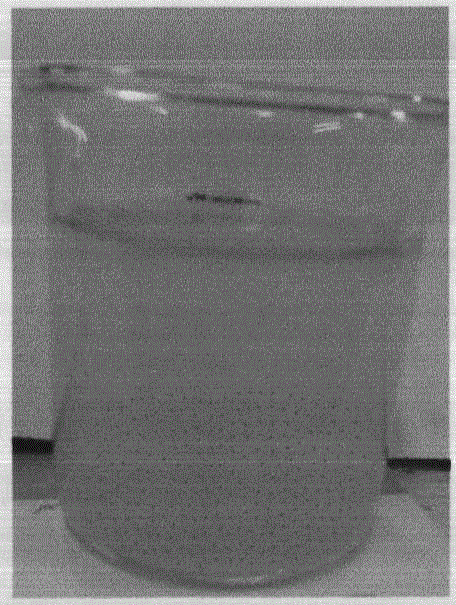Fly ash-based adsorption material utilizing fiber as pore forming agent
An adsorption material and fly ash technology, applied in the field of water treatment, can solve the problems of destroying the ecological environment, occupying farmland, polluting rivers and lakes, etc., and achieve the effect of low price, wide application and large specific surface area
- Summary
- Abstract
- Description
- Claims
- Application Information
AI Technical Summary
Problems solved by technology
Method used
Image
Examples
Embodiment 1
[0031] A preparation method of a fly ash-based adsorption material using fiber as a pore-forming agent, the steps are as follows:
[0032] 1) Disperse paper sludge to prepare fine fibers, such as figure 1 shown;
[0033] 2) Centrifuge the fiber suspension to remove excess water, such as figure 2 shown;
[0034] 3) Wet mixing: Weigh an appropriate amount of material according to the mass ratio of fly ash and bentonite of 2:1, pour it into the fiber suspension after centrifugal concentration, and mix evenly;
[0035] 4) The mixture is dried in an oven at 80°C to the initial weight of the raw material;
[0036] 5) Grind the dried material to a powder with a diameter of 0.5 mm, and stir to make it evenly mixed, such as image 3 shown;
[0037] 6) After adding an appropriate amount of distilled water to the powdery mixed material, use a particle molding machine to shape the material, such as Figure 4 shown;
[0038] 7) The molded material was left to dry naturally at room ...
Embodiment 2
[0046] Weigh 0.5g of this adsorption material and 0.5g of activated carbon, put them into conical flasks containing 100mL of methylene blue solution with a concentration of 2000mg / L, adjust the pH of the solution to 7 with NaOH or HCl, and place them in a constant temperature shaker , adjust the rotation speed to 120r / min, the temperature to 50°C, sample and filter at the set time of 1h, 3h, 6h, 18h, 22h, 28h, 42h, 48h, 72h, 96h, 120h, 144h and 168h, using UV- The absorbance of the filtrate was measured by a visible spectrophotometer, and the adsorption amount was calculated. The adsorption capacity of activated carbon to methylene blue adsorption saturation reached 256.01 mg / g, and the adsorption capacity of this new adsorption material reached 200.20 mg / g when methylene blue adsorption reached equilibrium.
Embodiment 3
[0048]Weigh 0.2g of this adsorption material and 0.2g of activated carbon, put them into conical flasks containing 100mL of gentian violet solution with a concentration of 1000mg / L, adjust the pH value of the solution to 7 with NaOH or HCl, and place it in a constant temperature shaker In the device, the speed is adjusted to 120r / min, the temperature is 50°C, and the samples are filtered at the set time of 1h, 3h, 6h, 18h, 22h, 28h, 42h, 48h, 72h, 96h, 120h, 144h and 168h, using ultraviolet - Measure the absorbance of the filtrate with a visible spectrophotometer and calculate its adsorption capacity. The adsorption capacity of activated carbon to gentian violet in equilibrium is 230.61 mg / g, and the adsorption capacity of this new adsorption material to gentian violet in equilibrium is 474.27 mg / g.
[0049] In embodiment 2 and embodiment 3, compare the adsorption effect of methylene blue and gentian violet in the dye wastewater with newly prepared adsorbent material and gac, ...
PUM
| Property | Measurement | Unit |
|---|---|---|
| Adsorption capacity | aaaaa | aaaaa |
| Adsorption capacity | aaaaa | aaaaa |
| Adsorption capacity | aaaaa | aaaaa |
Abstract
Description
Claims
Application Information
 Login to View More
Login to View More - R&D Engineer
- R&D Manager
- IP Professional
- Industry Leading Data Capabilities
- Powerful AI technology
- Patent DNA Extraction
Browse by: Latest US Patents, China's latest patents, Technical Efficacy Thesaurus, Application Domain, Technology Topic, Popular Technical Reports.
© 2024 PatSnap. All rights reserved.Legal|Privacy policy|Modern Slavery Act Transparency Statement|Sitemap|About US| Contact US: help@patsnap.com










